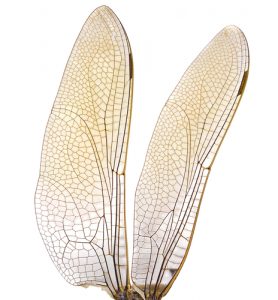Do All Insects Have Wings?
By Chris Williams on February 13, 2012.
Q. My brother and I made a bet about something and my mom said to ask you. My brother says all insects have wings when they get to be adults. I say he’s wrong. Fleas don’t have wings, do they? This is important because the winner gets the other guy’s allowance this week.
A. You can tell your brother that you win that bet, just remember to save some of that money for college. Maybe you’ll be an entomologist some day!
Your brother is almost right, however. Most insects do have wings. Fleas, lice, silverfish, and firebrats are the only truly wingless insect groups that most of us are familiar with. Most adult insects have two pairs of wings, but they’re not always visible. Often they’re hidden, shortened, or nonfunctional. You can easily see both pairs of clear wings on wasps, bees, ants, and termites. Their wings are held on top of their backs and the back pair is usually smaller than the front pair.
 A beetle doesn’t appear to have wings at all, yet the hard outer covering on the back of a beetle is actually a pair of modified wings. The second pair of clear, membranous wings are folded up underneath. When a beetle flies, the wing covers, or elytra, spread apart at the center and the flight wings beneath unfold. It all happens so fast though that you can rarely see it happen.
A beetle doesn’t appear to have wings at all, yet the hard outer covering on the back of a beetle is actually a pair of modified wings. The second pair of clear, membranous wings are folded up underneath. When a beetle flies, the wing covers, or elytra, spread apart at the center and the flight wings beneath unfold. It all happens so fast though that you can rarely see it happen.
In moths and butterflies, the forewings and the hindwings are covered with scales that create patterns and colors. Cockroaches, grasshoppers, and crickets have flight wings hidden under a leathery pair of front wing covers that match the rest of the body. Flies are the only insect group that has only one pair of functional wings. The hind wings are reduced to small, knobbed structures called halteres that act like little gyroscopes to help the fly keep its balance.
If you’ve ever watched a dragonfly at work, turning, diving, and hovering, you can appreciate the fact that certain flying insects can outmaneuver any other flying animal with the possible exception of the hummingbird.